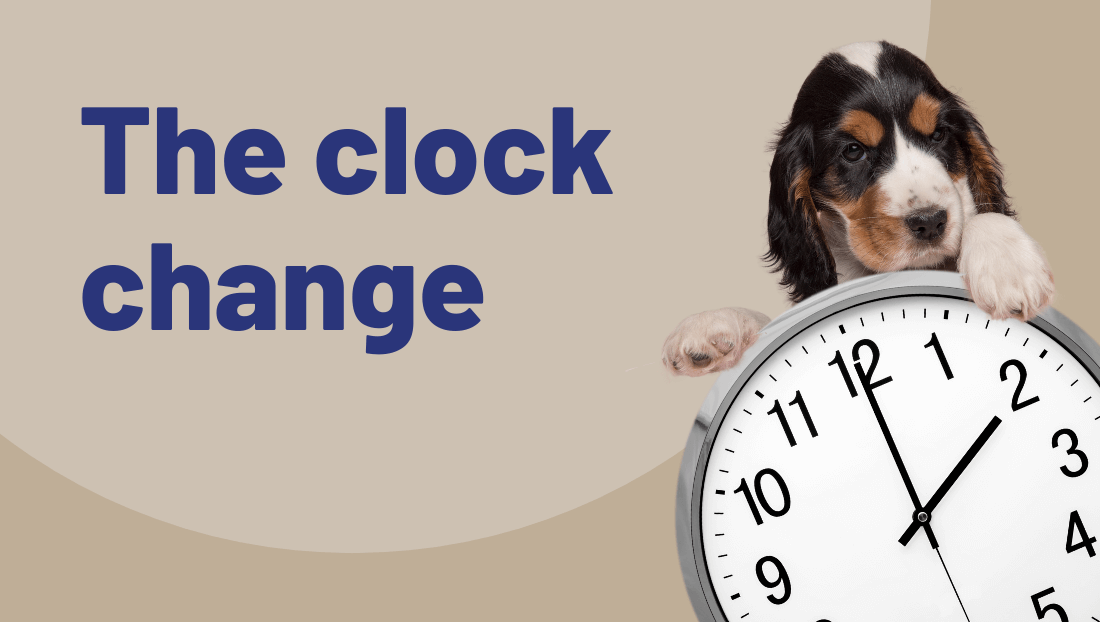
Daylight saving time and dogs: what is its impact and how to help them adapt?
When it’s time to change the clocks, it’s not just humans who feel the difference. Our pets are also affected by this time adjustment, even if they do not consult the clock. At Veterinari del Clínic, in Barcelona, we know how important it is to understand how the hour change impacts your dog and what you can do to make this process more bearable. Here we explain everything you need to know to take care of your dog during the hour change.
How daylight saving time affects dogs
Although it may seem that dogs live completely independent of time, the reality is that their habits and routines are closely linked to the light-dark cycle and the schedules set by their owners. When the schedule is moved forward or backward, dogs may experience different reactions, since their biological clock -their circadian rhythm- is altered.
At Veterinari del Clínic Barcelona we have observed that the most common changes in dogs after the hour change include:
- Sleep disturbances: dogs may take a few days to adjust to the new sleep routine, showing tiredness or, in some cases, waking up earlier or later than usual.
- Restlessness and anxiety: The change in schedule may unsettle sensitive dogs. Some may show signs of restlessness or anxiety, as they do not understand why their routine has been changed.
- Feeding mismatches: Feeding schedules are also affected by the time change. A dog that is used to eating at a set time may start asking for food earlier or later than expected, causing confusion for both pet and owner.
These responses to the time change are usually temporary, but at Veterinari del Clínic we recommend paying attention to how your dog reacts in order to help them in the best possible way.

How can we help them?
The good news is that there are effective ways to help your dog adapt to the new schedule with ease. At Veterinari del Clínic Barcelona, we suggest these useful tips:
- Adjust schedules gradually: If you know the hour change is coming, start modifying the schedules of your daily routines ahead of time. Adjust meals, walk and play times in small increments of 10 to 15 minutes per day during the week leading up to the change. This will help your dog adapt more gradually to the new schedule
- Be consistent with the routine: Once the hour change has happened, maintain consistency in the established schedules. Even if the clock shows a different time, your dog will feel more confident and less confused if you keep their regular activities.
- Take advantage of natural light: Daytime walks, especially during peak daylight hours, can be very helpful. Exposure to sunlight helps regulate dogs’ circadian rhythm and allows them to adapt more quickly to the new day/night cycle.
- Offer environmental enrichment: For dogs that feel more restless, providing stimulating activities and games can be a good way to keep their mind occupied and reduce stress. Interactive toys, training sessions and sniffing games are some options to calm anxiety.
- Observe and adapt: It is essential to observe your dog during the days following the hour change. Every dog is different and some may need more time to adjust. If you notice that your dog is especially restless or shows a prolonged change in behavior, consider visiting Veterinari del Clínic in Barcelona for further guidance.
Changing the hour can be a bit of a challenge for dogs, especially those who are more sensitive to changes in their daily routine. However, with a little planning and patience, it is possible to make this transition smooth and stress-free. Maintaining a stable routine, making gradual adjustments and taking advantage of daylight are key to making your pet feel comfortable and confident in this process. At Veterinari del Clínic, we are always at your disposal to help your pet go through these changes in the best possible way.




No Comments
Sorry, the comment form is closed at this time.